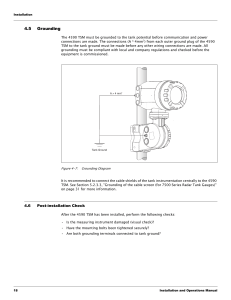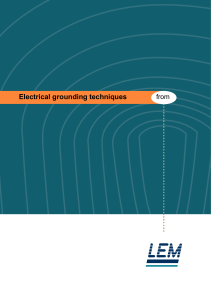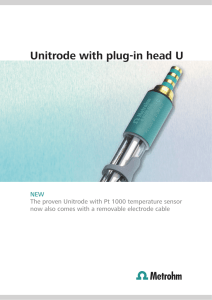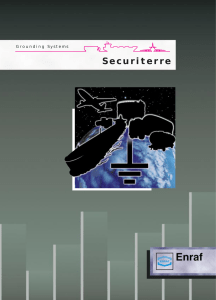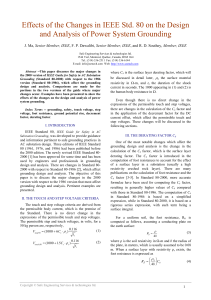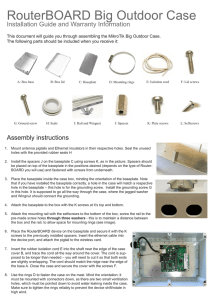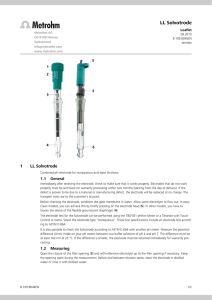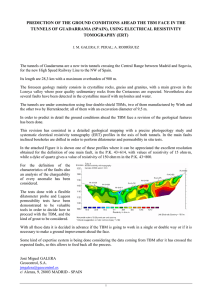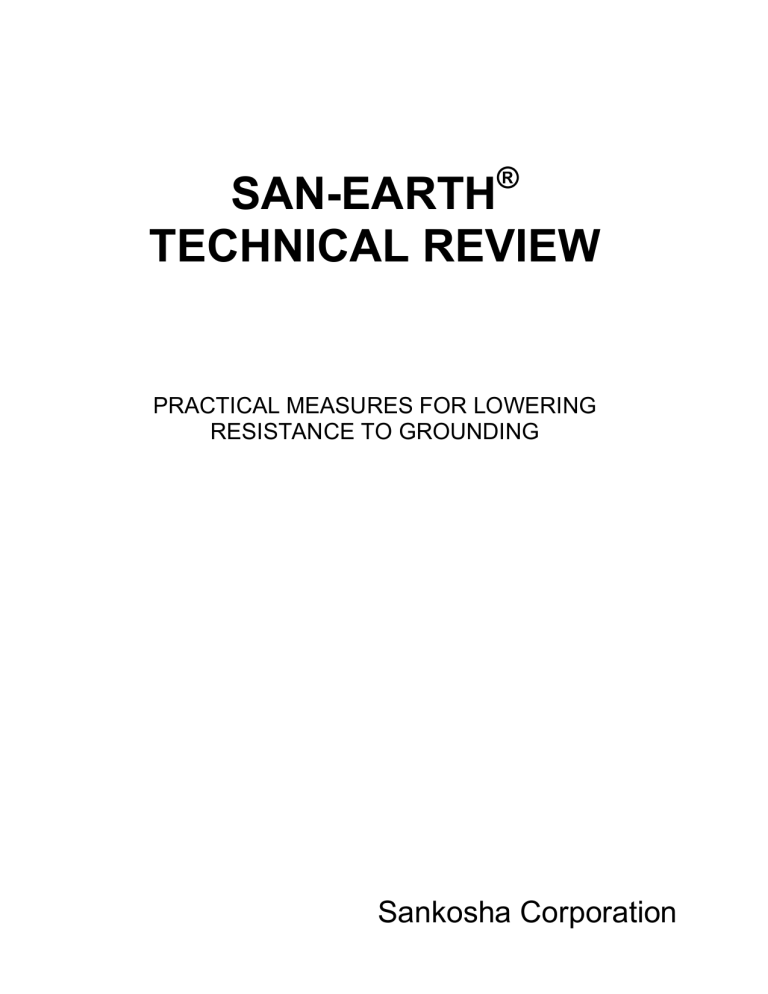
® SAN-EARTH TECHNICAL REVIEW PRACTICAL MEASURES FOR LOWERING RESISTANCE TO GROUNDING Sankosha Corporation Contents 1) Using SAN-EARTH to Reduce Grounding Resistance a) SAN-EARTH Product Features i) Excellent Grounding Qualities ii) Electrolytic Corrosion Resistance iii) Cost Efficient Grounding iv) Environmentally Safe b) SAN-EARTH Applications c) SAN-EARTH Ground Characteristics d) Long Term Resistance to Grounding with SAN-EARTH e) Resistance to Electrolytic Corrosion f) Typical SAN-EARTH Installations i) ii) SAN-EARTH (M5C) Conductive Cement Applications (1) Typical Grounding with M5C SAN-EARTH (2) Reducing Grounding Resistance in Transmission Towers (3) Power Station Grounding SAN-EARTH (M1) Conductive Cement Applications (1) Typical Grounding of Concrete Base (2) Grounding Structural Bases iii) Metal Earth Electrode Applications iv) SAN-EARTH Dissolution Test Results 2) SAN-EARTH Grounding Strategies a) Grounding Methods and their Features b) Grounding Resistance – General Description c) Soil Resistivity d) Soil Resistivity Measurement i) Wenner’s Four Electrode Method ii) Simple Bar Electrode Method (Grounding Rod) iii) Simple Measurement with SAN-EARTH iv) Simple Measurement with Counterpoise 1 e) Grounding Resistance Equations i) SAN-EARTH Covered Electrode ii) Parallel Electrodes iii) L-Shaped Electrodes iv) Cross Shaped Electrodes and Perimeter Electrodes v) Comparison of Grounding Resistance values of Various Shaped Electrodes 3) Submerged Grounding Electrode Covered with SAN-EARTH Conductive Concrete a) Third Class (Under 100 Ohm) Installation i) Placement of SAN-EARTH Covered Electrode ii) SAN-EARTH Conductive Covered Electrode Design iii) Results b) Cathodic Protection System Sacrificial Electrode Installation i) Placement of SAN-EARTH Covered Electrode ii) SAN-EARTH Sacrificial Electrode Design iii) Results 4) Practical Examples of SAN-EARTH Grounding a) SAN-EARTH M5C Grounding Procedures b) Ushizuma Passive Reflector Tower Grounding c) Fukui Thermal Power Station Grounding Repair d) Shin Mikawa Trunk Line Tower Grounding e) Tokai Nuclear Energy Research Institute Grounding f) Tokyo Monorail System Submerged Grounding Electrode (Near Tamachi) g) JR Kannon Tunnel Sacrificial Electrode (Installing Anti-Corrosive Electrodes) h) JR Echigo Line Grounding for Conversion from Diesel to Electric Line (Using Conductive SAN-EARTH MO “Bones”) i) Inspection of SAN-EARTH Grounding by Japan Railways (JR) j) SAN-EARTH Electrolysis Test 5) Bibliography 2 1. Using SAN-EARTH to Reduce Grounding Resistance SAN-EARTH is a powdery granular conductive material produced from chemically stable substances. Since its introduction to the market in 1979, SAN-EARTH has been in great demand among many customers and has been praised for it effectiveness in reducing grounding resistance. Applications for ten different patents have been submitted covering the various useful properties of SAN-EARTH. SAN-EARTH can be used in a variety of applications including the prevention of static electricity, electric wave screening and intersurface heating elements, but it has been most frequently used as a grounding material because of its convenience and effectiveness. SAN-EARTH is available in two forms, as a powder that can be spread over the ground and in a mixture that can be used in construction. a. SAN-EARTH Product Features i. Excellent Grounding Qualities SAN-EARTH, usually installed in dry powder form, is both convenient and effective. It makes ideal contact with the ground possible over large effective areas and has qualities far superior to more traditional grounding techniques. ii. Electrolytic Corrosion Resistance In normal conditions, an electrolytic reaction occurs when any metal buried in the ground is exposed to a positive electric current. That reaction caused by ionic conductivity results in serious corrosion of the metal. This condition can be avoided through the use of SAN-EARTH. Covering the metal with SAN-EARTH creates conduction between the metal and SAN-EARTH reducing the electrolytic reaction and preventing the metal from corroding. iii. Cost Efficient Grounding In general, no water is required when grounding with SAN-EARTH. Once installed, it absorbs moisture from the surrounding soil and hardens. Common obstacles such as rocks or stumps will not interfere with grounding and need not be removed. Because SAN-EARTH is granular and not liquid in nature, trouble free installation is possible even when the site is sloped. These factors combine for cost efficient grounding. iv. Environmentally Safe SAN-EARTH provides completely pollution free grounding because it is composed of very safe inert chemical matter. It will neither melt into the soil nor change into an electrolyte. 3 b. SAN-EARTH Applications i. Electric transmission and distribution towers ii. Power plant grounding grids iii. Microwave towers iv. Substation ground systems v. Surge protection systems vi. Cathodic protection systems vii. Central office systems viii. Cellular systems ix. Remote digital switches x. Computer systems xi. Fiber optics xii. Radio transmission towers xiii. Central office DC power xiv. Satellite ground stations c. SAN-EARTH Ground Characteristics SAN-EARTH vs. Bare Copper Wire Figure 1: Resistance to Ground Figure 2: Surge Impedance Surge Impedance in Ohms Resistance in Ohms 150 100 50 SAN-EARTH M5C Electrode Copper Ground Wire 60 50 40 30 Copper Ground Wire 20 SAN-EARTH M5C Electrode 10 10 20 30 0.1 Electrode Length in Meters (m) 1.0 5.0 10.0 Time in Microseconds (µsec) Electrode Depth: 0.5 meters SAN-EARTH Electrode Width: 0.5 meters Measured Soil Resistivities for Both Tests Depth 0.2 meters Resistivity at Indicated Depth 305.91 Ω-m Avg. Resistivity to Indicated Depth 305.91 Ω-m 0.5 1.72 meters 382.40 Ω-m 371.58 Ω-m Surge Waveform: 1/100 µsec Electrode Length: 40 meters SAN-EARTH Electrode Width: 0.5 meters 4.3 meters 185.80 Ω-m 232.24 Ω-m 6.88 meters 161.20 Ω-m 331.77 Ω-m 20.0 meters 47.40 Ω-m 236.98 Ω-m 4 d. Long Term Grounding Resistance with SAN-EARTH To observe the change in grounding resistance over a long period of time, five electrodes of various shapes as shown in Figure 3 were buried in the ground at the site of Sankosha Corporation’s Sagami Plant. Periodic measurements of electrode resistance continue to be taken and recorded as shown in Figure 4. Figure 3: Grounding Electrode Descriptions 5 Figure 4: Long Term Grounding Resistance 6 Figure 4: Long Term Grounding Resistance (continued) 7 Figure 4: Long Term Grounding Resistance (continued) e. Resistance to Electrolytic Corrosion To test SAN-EARTH’s ability to reduce electrolytic corrosion, two types of conductive concrete samples were prepared and a copper wire was placed in each. Samples made with both coarse grain (M1C) and fine grain (M5C) SAN-EARTH and were mixed in accordance with the JIS-R-5201 Standard, “Physical Test Method for Cement.” They were then submerged in ground water with an approximate specific resistance of 40 ohms on the premises of the JR Railway Technical Research Institute. Current values averaging 1.0 mA were applied and the accompanying reductions in the weight of the copper wires caused by electrolytic corrosion were measured to study the resistance to corrosion of the samples subjected to different voltages for various periods of time. Test results showed that the corrosion efficiency, a ratio of actual to theoretical (expected) corrosion, of the M1C and M5C SAN-EARTH was 5% and 10% respectively. The corrosion resistance of the samples imbedded in SAN-EARTH is especially high when compared to bare copper wire which would corrode away completely under the same conditions. The test results are summarized in Table 1. 8 Table 1: Electrolytic Corrosion Resistance Test Results Initial Weight (g) Weight After Test (g) Decrease (g) Quantity Theoretical Corrosion (g) 13.90 13.44 0.46 7.87 5.84 13.76 13.38 0.38 8.82 4.30 M1C 13.71 13.41 0.30 7.79 3.90 26 M1C 13.62 11.97 1.65 28.74 5.74 28 M5C 13.78 12.87 0.91 9.22 9.87 42 M5C 13.51 12.83 0.68 7.99 8.51 43 M5C 13.74 13.10 0.64 6.08 10.52 44 M5C 13.81 12.93 0.88 7.96 11.06 Specimen Number Class 12 M1C 13 M1C 14 Applied Voltage (V) +6 +6 Coefficient, Electrolytic Corrosion (%) Mean Coefficient, Electrolytic Corrosion (%) 4.9 10.0 In order to understand the effects of voltage on the bending and compressive strengths of the samples, these two characteristics were measured after the samples had been subjected to test voltages. The results of those tests are outlined in Table 2. Table 2: Average Bending and Compressive Strengths Test Item Class Bending Strength (kgf/cm) Compressive Strength (kgf/cm) M1C M5C Applied Voltage (V) -2 +2 -6 +6 0 Average M1C 51 55 50 52 56 53 M5C 49 44 46 49 49 47 Top 373 365 375 323 353 358 Bottom 400 393 388 335 370 377 Top 205 210 208 195 200 204 Bottom 215 213 218 203 208 211 9 f. Typical SAN-EARTH Installations i. SAN-EARTH (M5C) Conductive Cement Applications SAN-EARTH M5C is designed to solidify by absorbing the moisture in the surrounding soil. This makes it perfect for use in grounding at sites where a supply of water is not readily available. A ground wire is placed in a trench at the construction site. It is then covered completely with SAN-EARTH and the effective surface area of the grounding electrode is increased dramatically. (1) Typical Grounding with SAN-EARTH M5C 1. Place the ground wire in a trench. 2. Cover the ground wire completely with SAN-EARTH M5C and spread the SAN-EARTH in a thin layer covering the bottom of the trench. 3. Allow the SAN-EARTH to cover about 30 cm of the insulated portion of the ground wire. 4. Cover the SAN-EARTH with about 10 cm (4 inches) of soil and tamp it down until it is firmly packed. 5. Fill in the ditch completely with soil to complete the ground electrode installation. Figure 5: Typical Counterpoise Ground 10 (2) Reducing Grounding Resistance in Transmission Towers SAN-EARTH is ideal for reducing the grounding resistance in transmission and radio towers in mountain ranges or other areas where low resistance grounding can be difficult to secure because of high soil resistivity. Figure 6: Counterpoise Ground for Transmission Tower (3) Power Station Grounding Increasing difficulties in obtaining land and the tendency toward downsizing of electric facilities have caused a general shrinking in the land area used for electric plants making it more important than ever to effectively use the available land space for grounding. SAN-EARTH is ideal for maximizing grounding efficiency. Figure 7: Grounding Grid 11 ii. SAN-EARTH (M1) Conductive Cement Applications Taking advantage of the excavation typically required in building and/or tower construction, grounding with SAN-EARTH is very economical. All that is required is the placement of a grounding wire at the bottom of the excavation. The wire is then covered with SAN-EARTH M1 conductive cement, which has the same compressive strength as ordinary concrete. This means that SAN-EARTH M1 can be depended upon for both efficient grounding and as an integral part of the structure of buildings and towers. (1) Typical Grounding of Concrete Base (a) (b) (c) (d) Lay the grounding wire along the circumference of the excavation for the base. Cover the entire length of the wire with SAN-EARTH M1 mixed in a ratio of two parts SAN-EARTH to one part cement to 0.8 parts water as measured by weight. Allow about 30 cm (1 foot) of the insulated riser of the ground wire to be covered by the SAN-EARTH conductive cement. Complete the installation with regular cement. Figure 8 (2) Grounding Structural Bases Grounding concrete bases with SAN-EARTH effectively prevents them from being destroyed by lightning related surges. Because the installation of SANEARTH requires no additional excavation, it is a cost effective approach to grounding buildings and other structures. SAN-EARTH conductive concrete is extremely versatile and can be used in almost any location and application. 12 Figure 9: Tower Base iii. Figure 10: Building Base Metal Earth Electrode Applications (Cathodic Protection) (1) When two different types of metal such as copper and iron are held in contact with each other, a galvanizing action takes place between them resulting in the corrosion of the anode metal. This is a problem commonly encountered when placing grounding electrodes of copper wire or copper plate. It can be solved by completely covering the electrode with SAN-EARTH to prevent corrosion. (2) Until recently, one method of lowering grounding resistance was to spread charcoal powder (coke) around earth electrodes. However, this method often causes local electric current to flow from the ground conductor to the charcoal powder resulting in electrolytic corrosion in the electrode. Over a period of time, this can result in breaks in the ground wire. Because the charcoal (carbon) is slightly acetic, it causes the electrode to corrode as if it had been buried in acetic soil for a long period of time. For these reasons, in spite of its effectiveness in reducing grounding resistance, carbon powder is not frequently used. Using SAN-EARTH, which is 98% carbon in mixture with cement, to cover copper and iron electrodes greatly, reduces corrosion. This feature has been patented. Copper and iron generally will not corrode when embedded in solid concrete and corrosion is virtually eliminated in copper electrodes covered with SAN-EARTH cement. Iron electrodes, on the other hand, will be somewhat subject to galvanic corrosion before the conductive cement solidifies. This difference is due to the fact that the natural electrode potential of SAN-EARTH is lower than copper and higher than iron. In iron, the corrosion forms a thin layer of oxide-hydrate, which then hinders further corrosion and prevents serious damage to the electrode while having very little affect on contact resistance. Therefore, copper, its alloys, iron wire and iron bar can all be used effectively in SAN-EARTH conductive cement. 13 iv. SAN-EARTH Dissolution Test Results SAN-EARTH is a chemically stable substance extremely low in sulfate and chloride and, as such, will not pollute the environment. SAN-EARTH will not dissolve in the soil or in water. The results of dissolution testing are shown in Table 3 below. Table 3: SAN-EARTH Dissolution Test Result Chemical Test Result Test Method Alkyd Mercury Total Mercury Cadmium Lead Organic Phosphorus Hexadic Chromium Arsenic Cyanide PCB Not detected 0 mg/l 0 mg/l 0 mg/l 0 mg/l 0 mg/l 0 mg/l 0 mg/l 0 mg/l Environment Agency Notification No. 64 Environment Agency Notification No. 64 JIS K 0102-40 JIS K 0102-39 JIS K 0102-23.1 JIS K 0102-51.2 JIS K 0102-48 JIS K 0102-29.12, 29.2 JIS K 0093 Test Results Courtesy of the Kanagawa Prefectural Laboratory 2. SAN-EARTH Grounding Strategies a) Grounding Methods and their Features Before deciding on a grounding strategy, the type of earth electrode necessary to lower the grounding resistance to the level required should be considered. Strategies will be limited by the characteristics of the land, the land area and the type of structure to be grounded. It will also be necessary to consider any future construction plans. Table 4 shows the typical grounding strategies and their features. It should be noted that the comparisons in Table 4 are not based on a particular soils resistivity value or on a particular location but rather on general grounding conditions. Except in special grounding situations where particularly low resistance (5 ohms or less, for example) is required, the bar electrode and the plate electrode are acceptable as long as the soil resistivity of the site is low (100 ohm-m or less). In cases where the resistivity of the site is 200 ohm-m or more, effective grounding can only be accomplished by using more sophisticated techniques. The SAN-EARTH Conductive Concrete Strip is a grounding electrode composed of SAN-EARTH and cement. It provides a predictable reduction in grounding resistance regardless of the terrain and functions much like ordinary metal electrodes. The use of SAN-EARTH to increase the size and surface area of the electrode is far more effective and safer than the use of chemicals. 14 Table 4: Typical Grounding Strategies Grounding Electrode Features Typical Installation & Comments Effective Where Soil Resistivity Level is: Required Grounding Area Durability Cost Efficiency Ground Rod A straight or angled metal bar is driven into the ground. This is the simplest method of grounding and is effective where soil resistivity is low. Low Small 2 1 Plate Electrode A metal plate is buried in the ground either horizontally or vertically. This is a very common method for protection against lightning. Low Medium 1 2 Deeply Buried Electrode (Boring Method) An electrode is inserted into a deep hole 4-8 cm in diameter that has been mechanically bored into the ground. The area surrounding the electrode is then filled with bentonite or other backfill material. This method is recommended in areas where soil resistivity is high and/or space is limited. High Small 1 4 Counterpoise Electrode A conductor is laid horizontally in the ground. This method makes grounding possible where rocks or other obstacles are found. It is also suitable in areas where the site is sloped. Medium Medium 1 2 Grid Electrode A mesh or net conductor is laid horizontally in the ground. This method is also suitable for sloped sites. Medium Large 1 3 Conductive Concrete Strip Electrode A mixture of SAN-EARTH and cement hardener is spread around a conductor placed in a trench. The conductor and conductive cement solidify to form a grounding electrode. This method is suitable anywhere and is especially effective in areas where soil resistivity is very high. High Medium 1 1 Chemically Charged Grounding Systems An electrolytic agent is placed in or around the grounding electrode and buried in the ground. Medium Small 4 4 Durability & Cost Effectiveness: 1 = Excellent 2 = Good 3 = Need more data. Depends on installation site 4 = Not recommended 15 b) Grounding Resistance: General Description Grounding resistance is determined by the following factors. 1. 2. 3. The resistance of the grounding wire and the grounding electrode The contact resistance of the grounding electrode with the surrounding soil. The soil resistivity in the area around the electrode The most important of these factors is the third one, the soil resistivity around the electrode. When the dimensions of the electrode are known, resistance is expressed as follows: R = ρ x f (Formula 1.1) where: R = Grounding Resistance ρ = Soil Resistivity F = A function determined by the shape and size of the electrode As is evident in Formula 1.1 above, Grounding Resistance is proportionate to the soil resistivity of the site itself. It is therefore very important to know the soil resistivity of the construction site when making decisions about grounding methods. c) Soil Resistivity Since the grounding resistance of an electrode is proportionate to the resistivity of the grounding site, the lower the resistivity of a site, the easier it is to obtain a low resistance ground. Soil does not permit any electric current to flow when it is completely dry. It functions as an insulator in this condition which is demonstrated by the fact that silicon dioxide (SiO2) and aluminum oxide (AlO3), the chief ingredients of soil, have long been used as good insulating materials. However, soil is never found completely dry in its natural state. Soil loses its resistivity and becomes conductive quickly as it absorbs moisture as shown in Figure 11. However, even when it becomes conductive, it is a poor conductor when compared to metals. Therefore it is more aptly described as a semiconductor. Table 5 shows the comparative resistivity of various materials. The resistivity of copper is 10-8 ohm-m while the typical resistivity of soil is 102 ohm-m. This represents a ten decimal place difference. It is because of the low resistivities of metals when compared to the resistivity of soil that little thought is given to the resistance of the grounding electrode during its design. 16 Figure 11: Percentage of Moisture in Soil vs. Resistivity Table 5: Resistivity Ratings of Various Substances After moisture, the factor that has the biggest effect on the resistivity of soil is temperature. Table 6 shows how the resistivity of soil varies with changes in temperature and the rate of its increase as temperature declines. The moisture content of the soil in Table 6 is 15.2% of its total weight. The resistivity of the soil at -15°C is 45.9 times higher than the resistivity of the same soil at +20°C. The resistivity of soil is, in fact, influenced by many factors and it fluctuates constantly. It is lower in summer and higher in winter. Figure 12 shows the relationship between the time of year and soil resistivity. Temperature Ground Resistivity (Ω - m) 20˚ C 10˚ C 0˚ C 0˚ C (ice) -5˚ C -15˚ C 72 99 130 300 790 3,300 Rate 1.0 1.4 1.8 4.2 11.0 45.9 Table 6: Soil Temperature Vs Resistivity 17 Figure 12: Grounding Resistance and the Seasons It is not feasible to indicate the resistivity of any particular type of soil because the resistivity, of clay for example, will vary considerably depending on its location and the time it is measured. Some approximations are possible, however, and the resistivities of several typical classes of soil are given in Table 7. There are two ways to determine the resistivity of the soil at a certain site. The first is to actually measure the resistivity itself. The second is to drive a ground rod of known length and diameter into the ground and to measure its grounding resistance. That reading can then be used to calculate the resistivity of the surrounding soil. Class of Soil Paddy of Clay and Swamps Farmland of Clay Seaside Sandy Soil Paddy or Farmland with Gravel Stratum Mountains Gravel, Pebble Seashore or Parched River Bed Rocky Mountains Sandstone or Rocky Zone Resistivity (Ω - m) 10 10 50 100 200 1,000 2,000 104 ~ 150 ~ 200 ~ 100 ~ 1,000 ~ 2,000 ~ 5,000 ~ 5,000 ~ 107 Table 7: Classes of Soil and their Resistivity 18 The typical features of soils with certain resistivity values are shown in Table 8. Areas where the resistivity value exceeds 1,000 ohm-m are considered zones of high resistivity and grounding in such areas is very difficult. Generally, the earth is in layers and resistivity varies considerably depending on the layer or even at different depths within the same layer. Soil is therefore not consistent in resistivity values but rather unpredictable. Classification Resistivity ρ[Ω - m] Features Low Resistivity Zone ρ<100 Lowland at the mouths of rivers or by the sea. Usually abundant in water. Medium Resistivity Zone 100≤ρ<1,000 Midland plains where ground water is not so difficult to obtain. High Resistivity Zone ρ≥1,000 Hilly zones, piedmont districts and high lands, where drainage is good. Table 8: Classification of Soil Resistivity As explained earlier, the resistivity of soil is greatly influenced by its moisture content. The resistivity of the water itself also varies greatly and is dependent on the components of the water. Table 9 below illustrates the differences. Pure water is almost an insulating material in terms of its resistivity value. Type of Water Pure Water Distilled Water Rain Water Tap Water Well Water Mixture of River & Sea Water Sea Water (Inshore) Sea Water (Ocean 3%) Sea Water (Ocean 5%) Ω-m 200,000 50,000 200 70 20 ~ 70 2 0.3 0.2 ~ 0.25 0.15 Table 9: Resistivity of Water (Approximate Values) d) Soil Resistivity Measurement i) Wenner’s Four Electrode Method The best-known technique for measuring soil resistivity is Wenner’s Four Electrode Method. As shown in Figure 13, four electrodes are driven into the ground 19 in a straight line at equal spaces apart. Electrode C1 and C2 are connected and a flow of current is applied. The difference in the potential values at P1 and P2 is then measured. The difference in potential is divided by the applied current value to determine the resistance R(Ω). If the distance between the electrodes is “a”(m), the soil resistivity ρ (Ω-m) is determined using Formula 1.2 below. ρ = 2πaR Formula 1.2 Figure 13 Generally, as explained earlier, soil is found in layers and the resistivity will cary from layer to layer. By changing the spacing of the electrodes, it is possible to develop a profile of the soil resistivity at various depths. ii) Simple Bar Electrode Method (Ground Rod) A ground rod of known length and diameter is driven into the earth and the resistance is measured. The resistivity of the surrounding soil can then be determined using Formula 1.3 and solving for ρ. In Figure 14, if the resistance is R(Ω) when a grounding rod of length “L” and diameter “d” is driven into the ground, its resistivity (ρ) is described by Formula 13. ρ 4L R = 2.73L Log10 d Formula 1.3 Figure 14 20 Example: If the resistance of a ground rod that is 1.5 m long and 0.014 m in diameter is 100Ω, the resistivity of the soil can be determined as follows. 100 = ρ 2.73 x 1.5 ρ= 155.5 (Ω-m) Log10 4 x 1.5 0.014 Graph 1 on Page 22 shows the relationship between resistance and soil resistivity when a grounding rod 1.5 m long and 0.014 m in diameter is driven into the ground. The same relationship when multiple rods are driven at a distance of 3.0 m apart is also shown. iii) Simple Measurement with SAN-EARTH This method uses Formula 1.4 and the measured value of the resistance of a SANEarth electrode of known dimensions to determine the resistivity of the surrounding soil. In the example described in Figure 15, resistivity (Ω-m) can be calculated by solving the equation once resistance R(Ω) has been measured. ρ 2L2 Log10 R= WD 2.73L Formula 1.4 Figure 15 Example: If the measured resistance is 100Ω when SAN-EARTH is laid in a trench 0.5m deep, 0.5m wide and 0.5m long, the resistivity of the surrounding soil can be determined as follows. 100 = ρ 2.73 x 5 ρ= 593.2 (Ω-m) Log10 2 x 52 0.5 x 0.5 Graph 2 on Page 23 shows the relationship between grounding resistance and soil resistivity when a 0.5m wide SAN-EARTH electrode is buried 0.5m deep and ranges in length from 3 - 100m. 21 iv) Simple Measurement with Counterpoise wire If the length of an excavation, the diameter of the grounding wire, and its buried depth are known, the soil resistivity can be calculated by solving Formula 1.5 for ρ. In Figure 16, if the grounding resistance is R(Ω) when a counterpoise of length “L” and diameter “d” is buried at the depth “D”, thn the relationship between R and resistivity (ρ) can be expressed as follows. R= 2 ρ Log10 L dD 2.73L Formula 1.5 Figure 16 Example: If the grounding resistance is 100Ω when a grounding wire 0.0078m in diameter and 5m long is buried 0.5m deep, the resistivity of the surrounding soil can be determined as follows. 100 = ρ 2.73 x 5 ρ= 358.6 (Ω-m) Log10 52 0.0078 x 0.5 Graph 3 on Page 24 shows the relationship between grounding resistance and soil resistivity when a counterpoise wire 0.078m in diameter and 3 - 100m long is buried 0.5m deep in the ground. 22 Graph 1: Resistance vs. Resistivity – Simple Ground Rod 23 Graph 2: Resistance vs. Resistivity – SAN-EARTH Electrode Figure 18 24 Graph 2: Resistance vs. Resistivity – Counterpoise Wire Figure 19 25 d) Grounding Resistance Equations i) SAN-EARTH Covered Electrode If a counterpoise wire is buried in the ground and covered with a strip of SANEARTH conductive concrete of length “L” and width “W” at depth “D”, then its resistance R(Ω) is the same as that of a strip of metal buried horizontally in the ground. Therefore if ρ is the ground resistivity in Ω-m, then: Formula 1.6: Figure 20: SAN-EARTH Covered Electrode ii) Parallel Electrodes When two electrode strips of length “L” and width “W” are laid as shown in Figure 21 the combined resistance is calculated using Formula 1.7 below. Formula 1.7: Figure 21: Parallel Electrodes 26 iii) L-Shaped Electrode When two electrode strips are laid in the form of the letter “L” each having length L/2 and width “W” at the depth “D” as shown in Figure 22, the combined resistance is expressed by Formula 1.8 below. Formula 1.8: Figure 22: L-Shaped Electrodes iv) Cross Shaped Electrodes and Perimeter Electrodes When two electrode strips are laid in a cross and each has a length “L/2” and width “W” and they are buried at a depth “D”, the combined resistance is expressed by Formula 1.9 below. The same formula also expresses the resistance of four electrode strips laid in the shape of a square with sides measuring “L/4” as shown in Figure 24. Formula 1.9: Figure 23: Cross-Shaped Electrode Figure 24: Perimeter Electrode 27 v) Comparison of the Resistance of Various Shaped Electrodes Table 10 below shows the comparative grounding resistance values when a grounding strip 20m in length is laid in various patterns. Given that ρ = 100Ω-m, W=0.5m, and D=0.5m, then the resistance values for the various shapes are as follows. Shape of Electrode Strip (in straight line) Strips in Parallel (Where a=5m) Strip in Letter L Strip in Cross Strip with Middle Opening Resistance 6.4 6.4 6.6 7.1 7.1 Table 10: Resistance of Various Shaped Electrodes 3. Submerged Grounding Electrode Covered with SAN-EARTH Conductive Concrete Metal covered with SAN-EARTH conductive concrete makes an excellent anticorrosive electrode. The use of SAN-EARTH in ocean applications where corrosive action is very strong makes possible economical and effective anticorrosive grounding electrodes. To illustrate the use of SAN-EARTH concrete covered electrodes, two actual installations are explained below. a) Third Class (<100 ohm) Installation Location: A section of the Tokyo Monorail Line between Hamamatsu-cho and Oimachi Purpose: To provide grounding for the monorail telephone system. The Tokyo Monorail track is laid on PC Girders in Tokyo Bay. Originally grounding electrodes were placed in the water surrounding the pillars but the cables corroded very quickly and became disconnected. To remedy the situation, the Tokyo Monorail Company decided to use SAN-EARTH conductive concrete electrodes. Those electrodes were installed in March, 1982. 28 i) Placement of SAN-EARTH Covered Electrode Figure 25: Conductive Concrete Submerged Electrode Installation ii) SAN-EARTH Conductive Concrete Covered Electrode Design In the electrode for the Tokyo Monorail installation, a CV Cable 38mm in diameter was covered with SAN-EARTH concrete which was mixed, in the following proportions (by weight) M1 SAN-EARTH: Cement: Gravel: 2 parts 1 part 2 parts Total Weight: 100kg (Approx.) Angle bars were imbedded to prevent drifting with the current. Figure 26: Conductive Concrete Submerged Electrode Design 29 iii) Results A grounding resistance value of 0.6Ω was obtained. For comparison, another electrode (without SAN-EARTH) was placed in the sea nearby and the measured resistance of the electrode was found to be essentially the same as that of the SANEARTH covered electrode. b) Cathodic Protection System Sacrificial Electrode Installation Location: Kanmon Submarine Tunnel, Moji District Management Department Power Supply Section, Japan Railways (JR) Purpose: To provide a corrosion resistant sacrificial electrode in the Deshimachi Shaft of the Kanmon Tunnel. The rail tracks in the Kanmon Tunnel are exposed to seeping sea water and electrolytic corrosion was a problem because of the leakage of DC current. This caused damage in the form of corrosion of the tracks. In an effort to solve this problem, sheeted piles were driven into the seaside on the Shimonoseki side of the Deshimachi Shaft and were used as forced anode electrodes. However, there was considerable damage to the forced anode electrode caused by both the electrolytic corrosion resulting from the flow of electric current (with a mean current value of 40A) and from the natural corrosion caused by contact with the seawater. The problem was solved through the use of a SAN-EARTH conductive concrete covered electrode resistant to corrosion. i) Placement of the SAN-EARTH covered Electrode Figure 27: Sacrificial Electrode Installation 30 ii) SAN-EARTH Sacrificial Electrode Design Because the sacrificial electrode is exposed to a mean current of 40 Amps and a maximum current of 70 Amps, electrolytic corrosion will be substantial. Assuming the electrolytic equivalents of 10 kg/Amp-yr for copper and 9.1 kg/Amp-yr for iron, more than 400 kg of copper or 360 kg of iron can be expected to corrode per year through electrolysis. Adding the natural corrosive effects of sea water, it was obvious that the electrodes had to be designed to withstand a large amount of corrosion. Therefore, silicon cast iron was used for the central electrode and was then covered with SANEARTH and encased in a steel box. The SAN-EARTH was mixed two kg of SANEARTH to each kg of blast furnace cement. The total weight of the electrode was about 750 kg. Figure 28: Sacrificial Electrode Installation Because of the large current capacity two electrodes were constructed and each was buried 1.5m below sea level. The wire used to connect the electrode was laid in a trough which was then filled with cement to protect it against the waves and sand. A Resistance Value of less than 0.1 (Ω) was achieved. 31 4. Practical Examples of SAN-EARTH Grounding SAN-EARTH Packaging SAN-EARTH bags are designed for use at typical counterpoise excavations. SAN-EARTH M5C Grounding Procedures 1. Lay copper conductor along the center of the trench. 2. #2 AWG tinned solid wire is recommended. 3. Insulating the wire where it exits the cement is a good idea (Electrical tape works well for this). 4. Open a bag of SAN-EARTH and spread the material across the width of the trench by slowly dragging the bag along its length. 5. One bag of SAN-EARTH will cover about ten lateral feet in the trench. 32 6. Lift the wire slightly to allow the SAN-EARTH to get under it encircling the conductor. 8. Let the SAN-EARTH taper off to a depth of about one quarter inch at the edges of the trench and the electrode is complete. 7. The SAN-EARTH is then pushed into the middle of the trench with the feet so that the wire is completely covered. 9. Carefully cover the SANEARTH with soil to a depth of about 10 cm (4 inches). Make sure the wire is not exposed during this step. 10. Tamp down the dirt as you go along. 11. Compression is important. 12. At this point heavy equipment can be used to fill in the rest of the trench 33 Ushizuma Passive Reflector Tower Grounding A counterpoise wire covered with SAN-EARTH M1C was laid along the circumference of the bottom of the tower base. Installed hardened SAN-EARTH Fukui Thermal Power Station Grounding Repair A grounding wire was placed at the base of the building. It was then covered with SANEARTH M1C. 34 Shin-Mikawa Trunk Line Grounding Excavation for SAN-EARTH Grounding Laying SAN-EARTH M5C Tokai Nuclear Energy Research Institute Grounding Laying SAN-EARTH M5C Replacing soil with front end loader. 35 SAN-EARTH Electrolytic Corrosion Test SAN-EARTH covered wire Prior to burying Counterpoise wire 36 Normal counterpoise wire showing considerable corrosion SAN-EARTH covered electrode showing no observable corrosion 37 5. BIBLIOGRAPHY a) Taro Kawase’s “Ground Fault Protection & Grounding Technique” (July 1977) b) Electric Equipment Construction Technique Research Institute’s “Grounding Design & Protection Manual” (Sept. 1971) c) Standard Practices For Electric Equipment Installation d) Japanese Industrial Standard Committee’s “JIS A4201” e) The Railway Technical Research Institute, JNR’s Report on “Electrolytic Corrosion Resistance of Conductive Concrete For Grounding Purposes” (Dec. 1982) f) The Electrical Society Electrolytic Corrosion Prevention Research Committee’s “Handbook of Electrolysis & Soil Corrosion” (May 1977) g) Yoshimasa Shuno’s “The Transition of Resistance to Earth Reduction Agent” published by The Densetu Kogyo (May 1982) h) Central Electrical Research Institute’s Report No. 17030. “A Guide To Electric Distribution Line of Lightning Resistance” (March 1976) i) Central Electrical Research Institute’s Report No. 175031, “A Guide To Electric Distribution Line of Lightning Resistance” (March 1976) j) The Chubu Electric Power Co., Inc.’s Technical Research Report k) The Kansai Electric Power Co., Inc.’s Technical Research Report l) Kenkichi Nakahara’s “The Kanmon Tunnel’s Preventives Against Electrolytic Corrosion (Oct. 1983) m) Nihon Densetu Kogyo’s Technical Development Release 38 For More Information Contact: In the U.S.: In Southeast Asia: Sankosha U.S.A., Inc. 406 Amapola Avenue, Suite 135 Torrance, CA 90501 Toll Free: Phone: Fax: (888) 711-2436 (310) 320-1661 (310) 618-6869 Website: Email: www.sankosha-usa.com [email protected] Sankosha Engineering (Thailand) Co. Ltd. BB Building, 20th Floor 54 Sukhumvit 21 (Asoke) Road Klongtoey-Nua, Wattana Bangkok, 10110, THAILAND Phone: +66-2-258-1685 FAX: +66-2-047-3224 Email: [email protected] In Japan: Sankosha Corporation 4-3-8 Osaki Shinagawa-ku, Tokyo 141 Japan Phone: Fax: 81-3-3491-7181 81-3-3494-7574 Email: [email protected] 39
